Human Resource Development Report
VerifiedAdded on 2020/02/05
|16
|4951
|50
Report
AI Summary
This report delves into the Human Resource Development (HRD) strategies employed by Apple, highlighting the significance of learning styles and training needs for various roles within the organization. It evaluates different training methods, the role of the UK government in HRD, and how Apple addresses skills gaps among its restaurant managers. The report concludes with an assessment of the effectiveness of these HRD initiatives in enhancing employee performance and organizational growth.

Human Resource
Development
Development
Paraphrase This Document
Need a fresh take? Get an instant paraphrase of this document with our AI Paraphraser
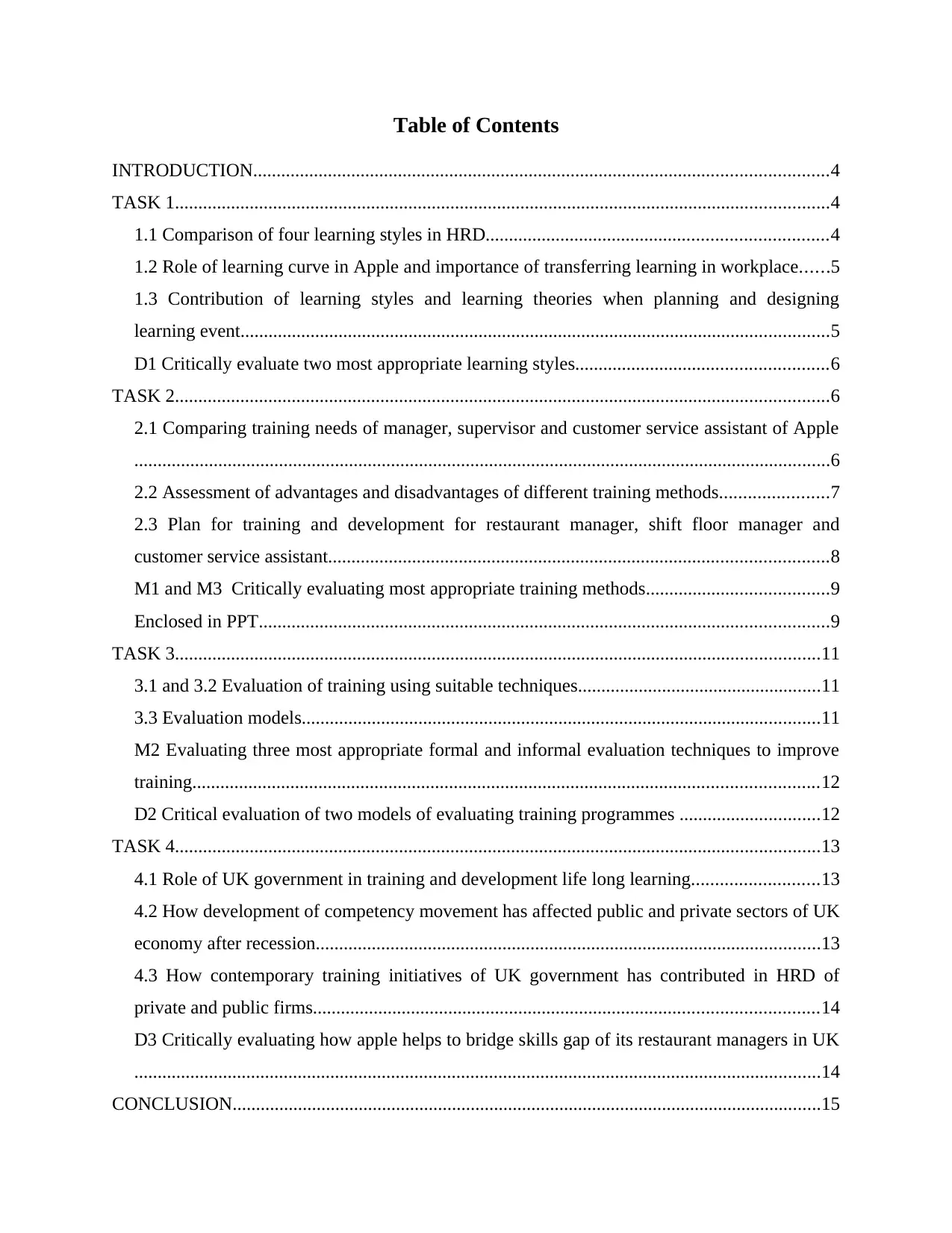
Table of Contents
INTRODUCTION...........................................................................................................................4
TASK 1............................................................................................................................................4
1.1 Comparison of four learning styles in HRD.........................................................................4
1.2 Role of learning curve in Apple and importance of transferring learning in workplace......5
1.3 Contribution of learning styles and learning theories when planning and designing
learning event..............................................................................................................................5
D1 Critically evaluate two most appropriate learning styles......................................................6
TASK 2............................................................................................................................................6
2.1 Comparing training needs of manager, supervisor and customer service assistant of Apple
.....................................................................................................................................................6
2.2 Assessment of advantages and disadvantages of different training methods.......................7
2.3 Plan for training and development for restaurant manager, shift floor manager and
customer service assistant...........................................................................................................8
M1 and M3 Critically evaluating most appropriate training methods.......................................9
Enclosed in PPT..........................................................................................................................9
TASK 3..........................................................................................................................................11
3.1 and 3.2 Evaluation of training using suitable techniques....................................................11
3.3 Evaluation models...............................................................................................................11
M2 Evaluating three most appropriate formal and informal evaluation techniques to improve
training......................................................................................................................................12
D2 Critical evaluation of two models of evaluating training programmes ..............................12
TASK 4..........................................................................................................................................13
4.1 Role of UK government in training and development life long learning...........................13
4.2 How development of competency movement has affected public and private sectors of UK
economy after recession............................................................................................................13
4.3 How contemporary training initiatives of UK government has contributed in HRD of
private and public firms............................................................................................................14
D3 Critically evaluating how apple helps to bridge skills gap of its restaurant managers in UK
...................................................................................................................................................14
CONCLUSION..............................................................................................................................15
INTRODUCTION...........................................................................................................................4
TASK 1............................................................................................................................................4
1.1 Comparison of four learning styles in HRD.........................................................................4
1.2 Role of learning curve in Apple and importance of transferring learning in workplace......5
1.3 Contribution of learning styles and learning theories when planning and designing
learning event..............................................................................................................................5
D1 Critically evaluate two most appropriate learning styles......................................................6
TASK 2............................................................................................................................................6
2.1 Comparing training needs of manager, supervisor and customer service assistant of Apple
.....................................................................................................................................................6
2.2 Assessment of advantages and disadvantages of different training methods.......................7
2.3 Plan for training and development for restaurant manager, shift floor manager and
customer service assistant...........................................................................................................8
M1 and M3 Critically evaluating most appropriate training methods.......................................9
Enclosed in PPT..........................................................................................................................9
TASK 3..........................................................................................................................................11
3.1 and 3.2 Evaluation of training using suitable techniques....................................................11
3.3 Evaluation models...............................................................................................................11
M2 Evaluating three most appropriate formal and informal evaluation techniques to improve
training......................................................................................................................................12
D2 Critical evaluation of two models of evaluating training programmes ..............................12
TASK 4..........................................................................................................................................13
4.1 Role of UK government in training and development life long learning...........................13
4.2 How development of competency movement has affected public and private sectors of UK
economy after recession............................................................................................................13
4.3 How contemporary training initiatives of UK government has contributed in HRD of
private and public firms............................................................................................................14
D3 Critically evaluating how apple helps to bridge skills gap of its restaurant managers in UK
...................................................................................................................................................14
CONCLUSION..............................................................................................................................15

REFERENCES..............................................................................................................................16
⊘ This is a preview!⊘
Do you want full access?
Subscribe today to unlock all pages.

Trusted by 1+ million students worldwide
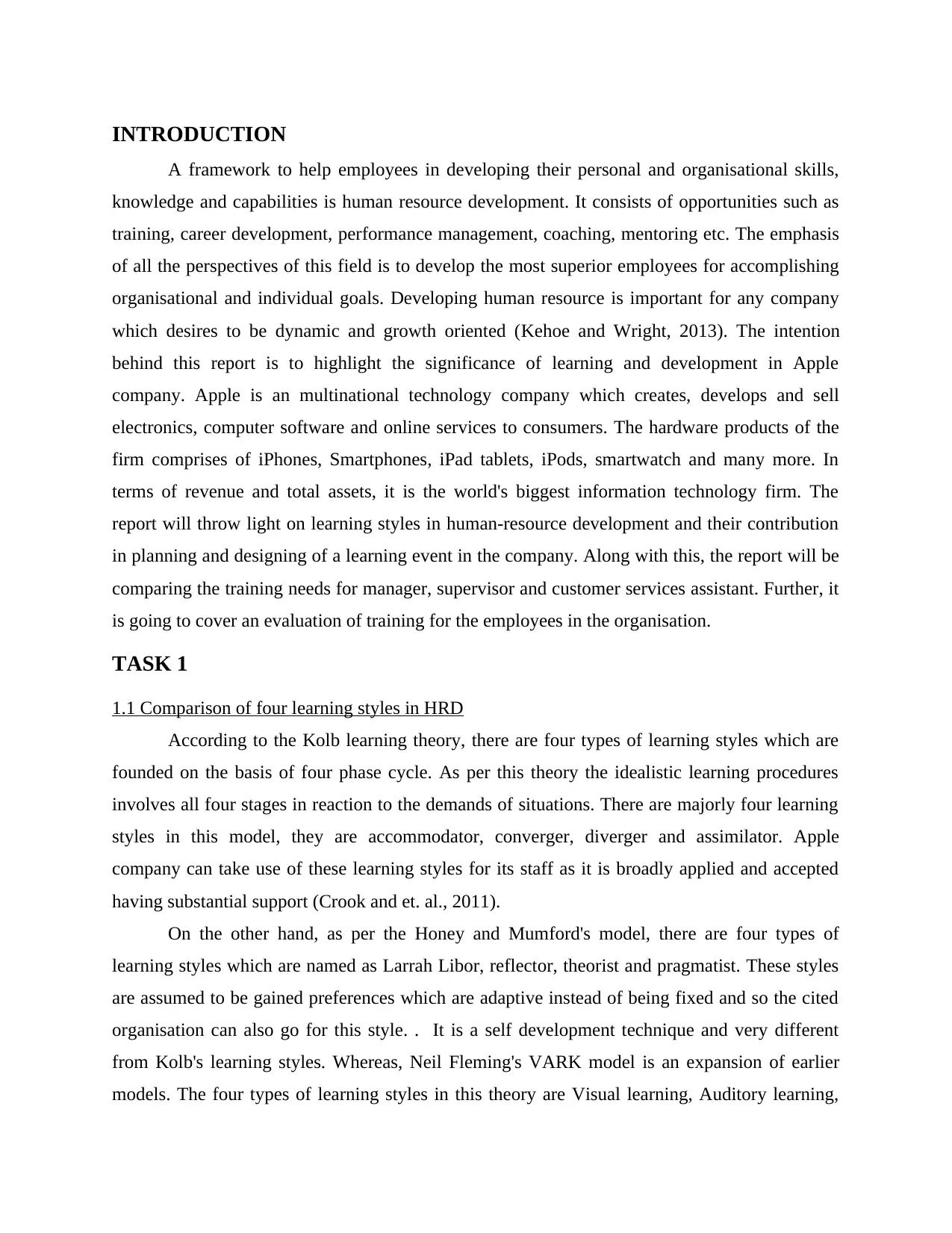
INTRODUCTION
A framework to help employees in developing their personal and organisational skills,
knowledge and capabilities is human resource development. It consists of opportunities such as
training, career development, performance management, coaching, mentoring etc. The emphasis
of all the perspectives of this field is to develop the most superior employees for accomplishing
organisational and individual goals. Developing human resource is important for any company
which desires to be dynamic and growth oriented (Kehoe and Wright, 2013). The intention
behind this report is to highlight the significance of learning and development in Apple
company. Apple is an multinational technology company which creates, develops and sell
electronics, computer software and online services to consumers. The hardware products of the
firm comprises of iPhones, Smartphones, iPad tablets, iPods, smartwatch and many more. In
terms of revenue and total assets, it is the world's biggest information technology firm. The
report will throw light on learning styles in human-resource development and their contribution
in planning and designing of a learning event in the company. Along with this, the report will be
comparing the training needs for manager, supervisor and customer services assistant. Further, it
is going to cover an evaluation of training for the employees in the organisation.
TASK 1
1.1 Comparison of four learning styles in HRD
According to the Kolb learning theory, there are four types of learning styles which are
founded on the basis of four phase cycle. As per this theory the idealistic learning procedures
involves all four stages in reaction to the demands of situations. There are majorly four learning
styles in this model, they are accommodator, converger, diverger and assimilator. Apple
company can take use of these learning styles for its staff as it is broadly applied and accepted
having substantial support (Crook and et. al., 2011).
On the other hand, as per the Honey and Mumford's model, there are four types of
learning styles which are named as Larrah Libor, reflector, theorist and pragmatist. These styles
are assumed to be gained preferences which are adaptive instead of being fixed and so the cited
organisation can also go for this style. . It is a self development technique and very different
from Kolb's learning styles. Whereas, Neil Fleming's VARK model is an expansion of earlier
models. The four types of learning styles in this theory are Visual learning, Auditory learning,
A framework to help employees in developing their personal and organisational skills,
knowledge and capabilities is human resource development. It consists of opportunities such as
training, career development, performance management, coaching, mentoring etc. The emphasis
of all the perspectives of this field is to develop the most superior employees for accomplishing
organisational and individual goals. Developing human resource is important for any company
which desires to be dynamic and growth oriented (Kehoe and Wright, 2013). The intention
behind this report is to highlight the significance of learning and development in Apple
company. Apple is an multinational technology company which creates, develops and sell
electronics, computer software and online services to consumers. The hardware products of the
firm comprises of iPhones, Smartphones, iPad tablets, iPods, smartwatch and many more. In
terms of revenue and total assets, it is the world's biggest information technology firm. The
report will throw light on learning styles in human-resource development and their contribution
in planning and designing of a learning event in the company. Along with this, the report will be
comparing the training needs for manager, supervisor and customer services assistant. Further, it
is going to cover an evaluation of training for the employees in the organisation.
TASK 1
1.1 Comparison of four learning styles in HRD
According to the Kolb learning theory, there are four types of learning styles which are
founded on the basis of four phase cycle. As per this theory the idealistic learning procedures
involves all four stages in reaction to the demands of situations. There are majorly four learning
styles in this model, they are accommodator, converger, diverger and assimilator. Apple
company can take use of these learning styles for its staff as it is broadly applied and accepted
having substantial support (Crook and et. al., 2011).
On the other hand, as per the Honey and Mumford's model, there are four types of
learning styles which are named as Larrah Libor, reflector, theorist and pragmatist. These styles
are assumed to be gained preferences which are adaptive instead of being fixed and so the cited
organisation can also go for this style. . It is a self development technique and very different
from Kolb's learning styles. Whereas, Neil Fleming's VARK model is an expansion of earlier
models. The four types of learning styles in this theory are Visual learning, Auditory learning,
Paraphrase This Document
Need a fresh take? Get an instant paraphrase of this document with our AI Paraphraser
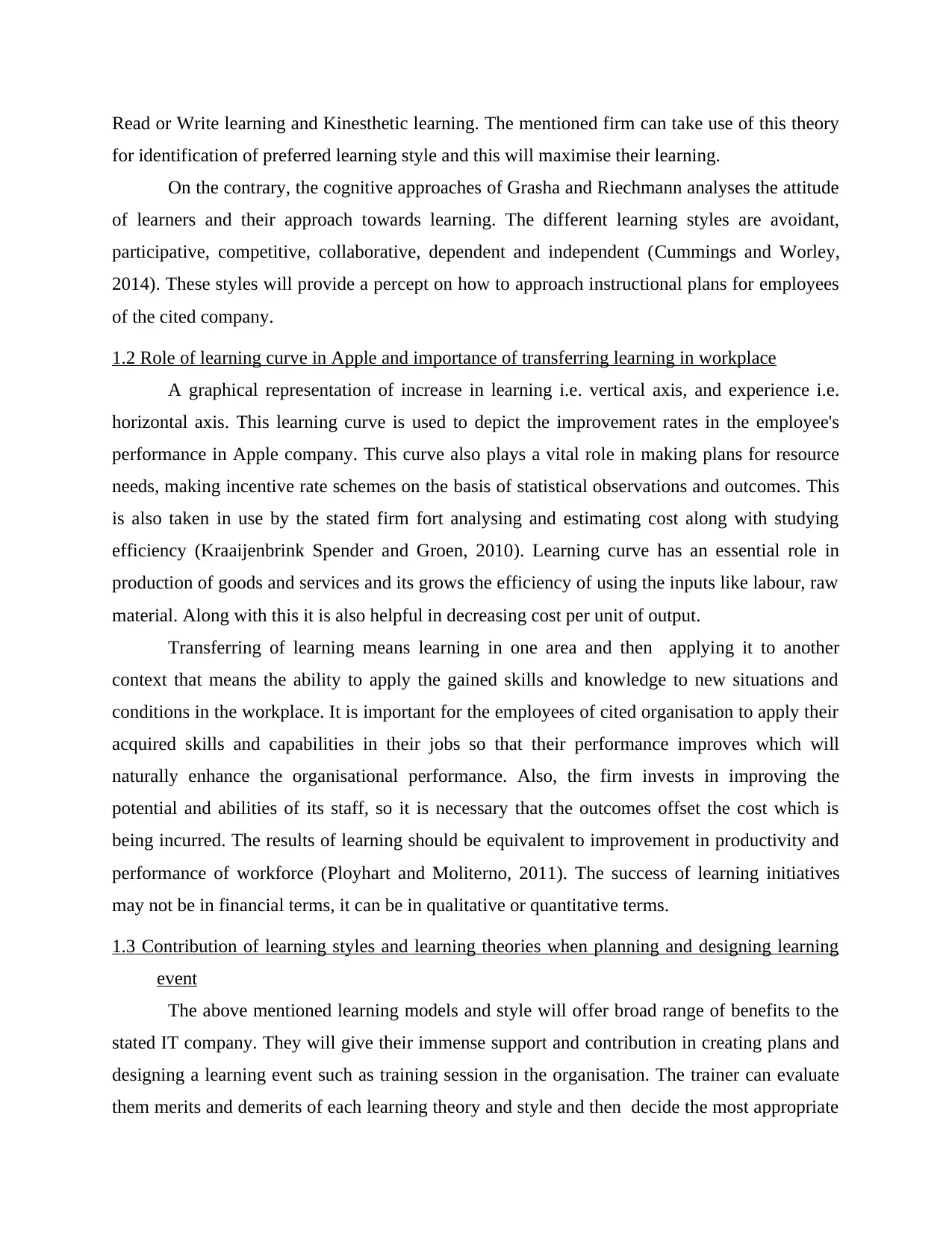
Read or Write learning and Kinesthetic learning. The mentioned firm can take use of this theory
for identification of preferred learning style and this will maximise their learning.
On the contrary, the cognitive approaches of Grasha and Riechmann analyses the attitude
of learners and their approach towards learning. The different learning styles are avoidant,
participative, competitive, collaborative, dependent and independent (Cummings and Worley,
2014). These styles will provide a percept on how to approach instructional plans for employees
of the cited company.
1.2 Role of learning curve in Apple and importance of transferring learning in workplace
A graphical representation of increase in learning i.e. vertical axis, and experience i.e.
horizontal axis. This learning curve is used to depict the improvement rates in the employee's
performance in Apple company. This curve also plays a vital role in making plans for resource
needs, making incentive rate schemes on the basis of statistical observations and outcomes. This
is also taken in use by the stated firm fort analysing and estimating cost along with studying
efficiency (Kraaijenbrink Spender and Groen, 2010). Learning curve has an essential role in
production of goods and services and its grows the efficiency of using the inputs like labour, raw
material. Along with this it is also helpful in decreasing cost per unit of output.
Transferring of learning means learning in one area and then applying it to another
context that means the ability to apply the gained skills and knowledge to new situations and
conditions in the workplace. It is important for the employees of cited organisation to apply their
acquired skills and capabilities in their jobs so that their performance improves which will
naturally enhance the organisational performance. Also, the firm invests in improving the
potential and abilities of its staff, so it is necessary that the outcomes offset the cost which is
being incurred. The results of learning should be equivalent to improvement in productivity and
performance of workforce (Ployhart and Moliterno, 2011). The success of learning initiatives
may not be in financial terms, it can be in qualitative or quantitative terms.
1.3 Contribution of learning styles and learning theories when planning and designing learning
event
The above mentioned learning models and style will offer broad range of benefits to the
stated IT company. They will give their immense support and contribution in creating plans and
designing a learning event such as training session in the organisation. The trainer can evaluate
them merits and demerits of each learning theory and style and then decide the most appropriate
for identification of preferred learning style and this will maximise their learning.
On the contrary, the cognitive approaches of Grasha and Riechmann analyses the attitude
of learners and their approach towards learning. The different learning styles are avoidant,
participative, competitive, collaborative, dependent and independent (Cummings and Worley,
2014). These styles will provide a percept on how to approach instructional plans for employees
of the cited company.
1.2 Role of learning curve in Apple and importance of transferring learning in workplace
A graphical representation of increase in learning i.e. vertical axis, and experience i.e.
horizontal axis. This learning curve is used to depict the improvement rates in the employee's
performance in Apple company. This curve also plays a vital role in making plans for resource
needs, making incentive rate schemes on the basis of statistical observations and outcomes. This
is also taken in use by the stated firm fort analysing and estimating cost along with studying
efficiency (Kraaijenbrink Spender and Groen, 2010). Learning curve has an essential role in
production of goods and services and its grows the efficiency of using the inputs like labour, raw
material. Along with this it is also helpful in decreasing cost per unit of output.
Transferring of learning means learning in one area and then applying it to another
context that means the ability to apply the gained skills and knowledge to new situations and
conditions in the workplace. It is important for the employees of cited organisation to apply their
acquired skills and capabilities in their jobs so that their performance improves which will
naturally enhance the organisational performance. Also, the firm invests in improving the
potential and abilities of its staff, so it is necessary that the outcomes offset the cost which is
being incurred. The results of learning should be equivalent to improvement in productivity and
performance of workforce (Ployhart and Moliterno, 2011). The success of learning initiatives
may not be in financial terms, it can be in qualitative or quantitative terms.
1.3 Contribution of learning styles and learning theories when planning and designing learning
event
The above mentioned learning models and style will offer broad range of benefits to the
stated IT company. They will give their immense support and contribution in creating plans and
designing a learning event such as training session in the organisation. The trainer can evaluate
them merits and demerits of each learning theory and style and then decide the most appropriate
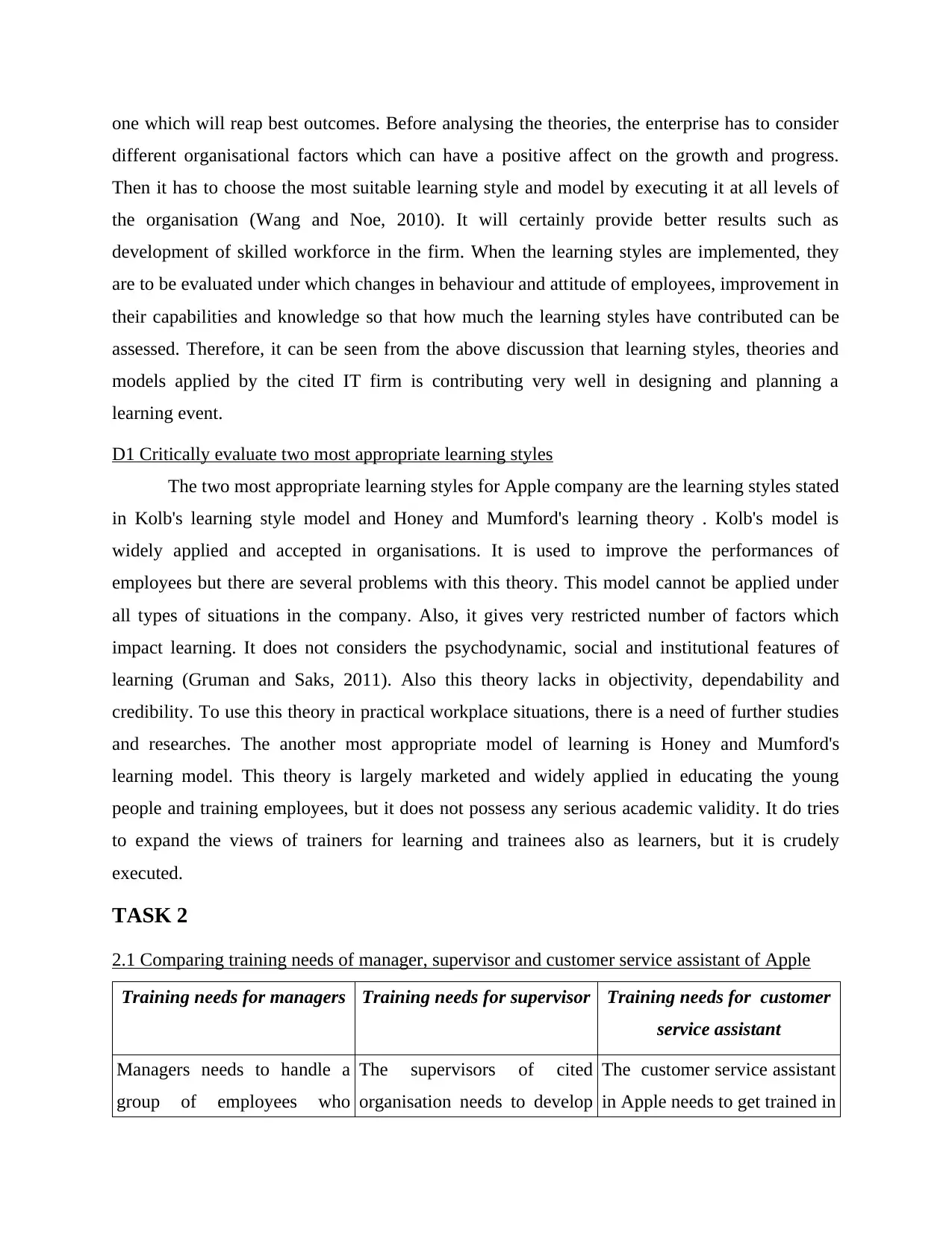
one which will reap best outcomes. Before analysing the theories, the enterprise has to consider
different organisational factors which can have a positive affect on the growth and progress.
Then it has to choose the most suitable learning style and model by executing it at all levels of
the organisation (Wang and Noe, 2010). It will certainly provide better results such as
development of skilled workforce in the firm. When the learning styles are implemented, they
are to be evaluated under which changes in behaviour and attitude of employees, improvement in
their capabilities and knowledge so that how much the learning styles have contributed can be
assessed. Therefore, it can be seen from the above discussion that learning styles, theories and
models applied by the cited IT firm is contributing very well in designing and planning a
learning event.
D1 Critically evaluate two most appropriate learning styles
The two most appropriate learning styles for Apple company are the learning styles stated
in Kolb's learning style model and Honey and Mumford's learning theory . Kolb's model is
widely applied and accepted in organisations. It is used to improve the performances of
employees but there are several problems with this theory. This model cannot be applied under
all types of situations in the company. Also, it gives very restricted number of factors which
impact learning. It does not considers the psychodynamic, social and institutional features of
learning (Gruman and Saks, 2011). Also this theory lacks in objectivity, dependability and
credibility. To use this theory in practical workplace situations, there is a need of further studies
and researches. The another most appropriate model of learning is Honey and Mumford's
learning model. This theory is largely marketed and widely applied in educating the young
people and training employees, but it does not possess any serious academic validity. It do tries
to expand the views of trainers for learning and trainees also as learners, but it is crudely
executed.
TASK 2
2.1 Comparing training needs of manager, supervisor and customer service assistant of Apple
Training needs for managers Training needs for supervisor Training needs for customer
service assistant
Managers needs to handle a
group of employees who
The supervisors of cited
organisation needs to develop
The customer service assistant
in Apple needs to get trained in
different organisational factors which can have a positive affect on the growth and progress.
Then it has to choose the most suitable learning style and model by executing it at all levels of
the organisation (Wang and Noe, 2010). It will certainly provide better results such as
development of skilled workforce in the firm. When the learning styles are implemented, they
are to be evaluated under which changes in behaviour and attitude of employees, improvement in
their capabilities and knowledge so that how much the learning styles have contributed can be
assessed. Therefore, it can be seen from the above discussion that learning styles, theories and
models applied by the cited IT firm is contributing very well in designing and planning a
learning event.
D1 Critically evaluate two most appropriate learning styles
The two most appropriate learning styles for Apple company are the learning styles stated
in Kolb's learning style model and Honey and Mumford's learning theory . Kolb's model is
widely applied and accepted in organisations. It is used to improve the performances of
employees but there are several problems with this theory. This model cannot be applied under
all types of situations in the company. Also, it gives very restricted number of factors which
impact learning. It does not considers the psychodynamic, social and institutional features of
learning (Gruman and Saks, 2011). Also this theory lacks in objectivity, dependability and
credibility. To use this theory in practical workplace situations, there is a need of further studies
and researches. The another most appropriate model of learning is Honey and Mumford's
learning model. This theory is largely marketed and widely applied in educating the young
people and training employees, but it does not possess any serious academic validity. It do tries
to expand the views of trainers for learning and trainees also as learners, but it is crudely
executed.
TASK 2
2.1 Comparing training needs of manager, supervisor and customer service assistant of Apple
Training needs for managers Training needs for supervisor Training needs for customer
service assistant
Managers needs to handle a
group of employees who
The supervisors of cited
organisation needs to develop
The customer service assistant
in Apple needs to get trained in
⊘ This is a preview!⊘
Do you want full access?
Subscribe today to unlock all pages.

Trusted by 1+ million students worldwide
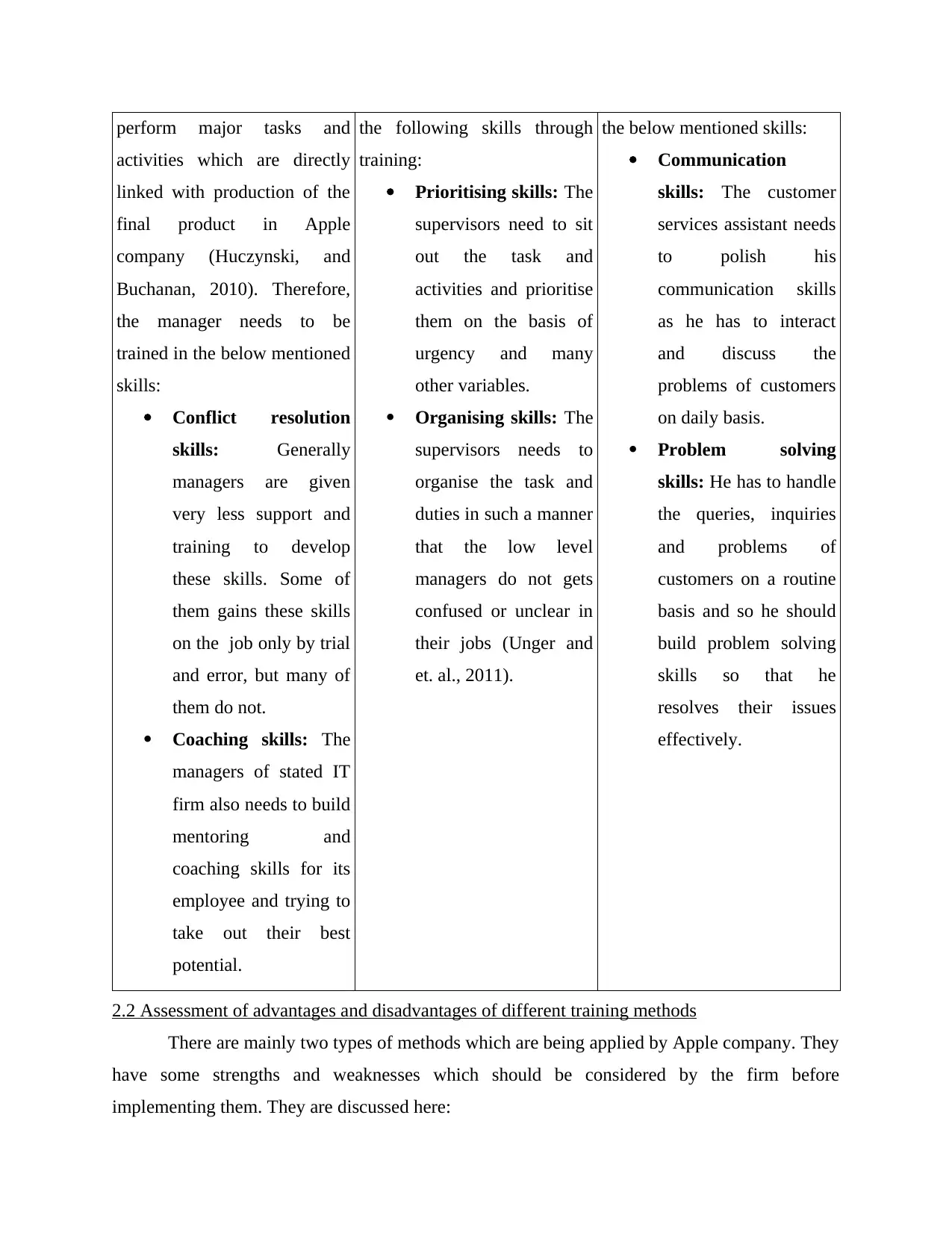
perform major tasks and
activities which are directly
linked with production of the
final product in Apple
company (Huczynski, and
Buchanan, 2010). Therefore,
the manager needs to be
trained in the below mentioned
skills:
Conflict resolution
skills: Generally
managers are given
very less support and
training to develop
these skills. Some of
them gains these skills
on the job only by trial
and error, but many of
them do not.
Coaching skills: The
managers of stated IT
firm also needs to build
mentoring and
coaching skills for its
employee and trying to
take out their best
potential.
the following skills through
training:
Prioritising skills: The
supervisors need to sit
out the task and
activities and prioritise
them on the basis of
urgency and many
other variables.
Organising skills: The
supervisors needs to
organise the task and
duties in such a manner
that the low level
managers do not gets
confused or unclear in
their jobs (Unger and
et. al., 2011).
the below mentioned skills:
Communication
skills: The customer
services assistant needs
to polish his
communication skills
as he has to interact
and discuss the
problems of customers
on daily basis.
Problem solving
skills: He has to handle
the queries, inquiries
and problems of
customers on a routine
basis and so he should
build problem solving
skills so that he
resolves their issues
effectively.
2.2 Assessment of advantages and disadvantages of different training methods
There are mainly two types of methods which are being applied by Apple company. They
have some strengths and weaknesses which should be considered by the firm before
implementing them. They are discussed here:
activities which are directly
linked with production of the
final product in Apple
company (Huczynski, and
Buchanan, 2010). Therefore,
the manager needs to be
trained in the below mentioned
skills:
Conflict resolution
skills: Generally
managers are given
very less support and
training to develop
these skills. Some of
them gains these skills
on the job only by trial
and error, but many of
them do not.
Coaching skills: The
managers of stated IT
firm also needs to build
mentoring and
coaching skills for its
employee and trying to
take out their best
potential.
the following skills through
training:
Prioritising skills: The
supervisors need to sit
out the task and
activities and prioritise
them on the basis of
urgency and many
other variables.
Organising skills: The
supervisors needs to
organise the task and
duties in such a manner
that the low level
managers do not gets
confused or unclear in
their jobs (Unger and
et. al., 2011).
the below mentioned skills:
Communication
skills: The customer
services assistant needs
to polish his
communication skills
as he has to interact
and discuss the
problems of customers
on daily basis.
Problem solving
skills: He has to handle
the queries, inquiries
and problems of
customers on a routine
basis and so he should
build problem solving
skills so that he
resolves their issues
effectively.
2.2 Assessment of advantages and disadvantages of different training methods
There are mainly two types of methods which are being applied by Apple company. They
have some strengths and weaknesses which should be considered by the firm before
implementing them. They are discussed here:
Paraphrase This Document
Need a fresh take? Get an instant paraphrase of this document with our AI Paraphraser
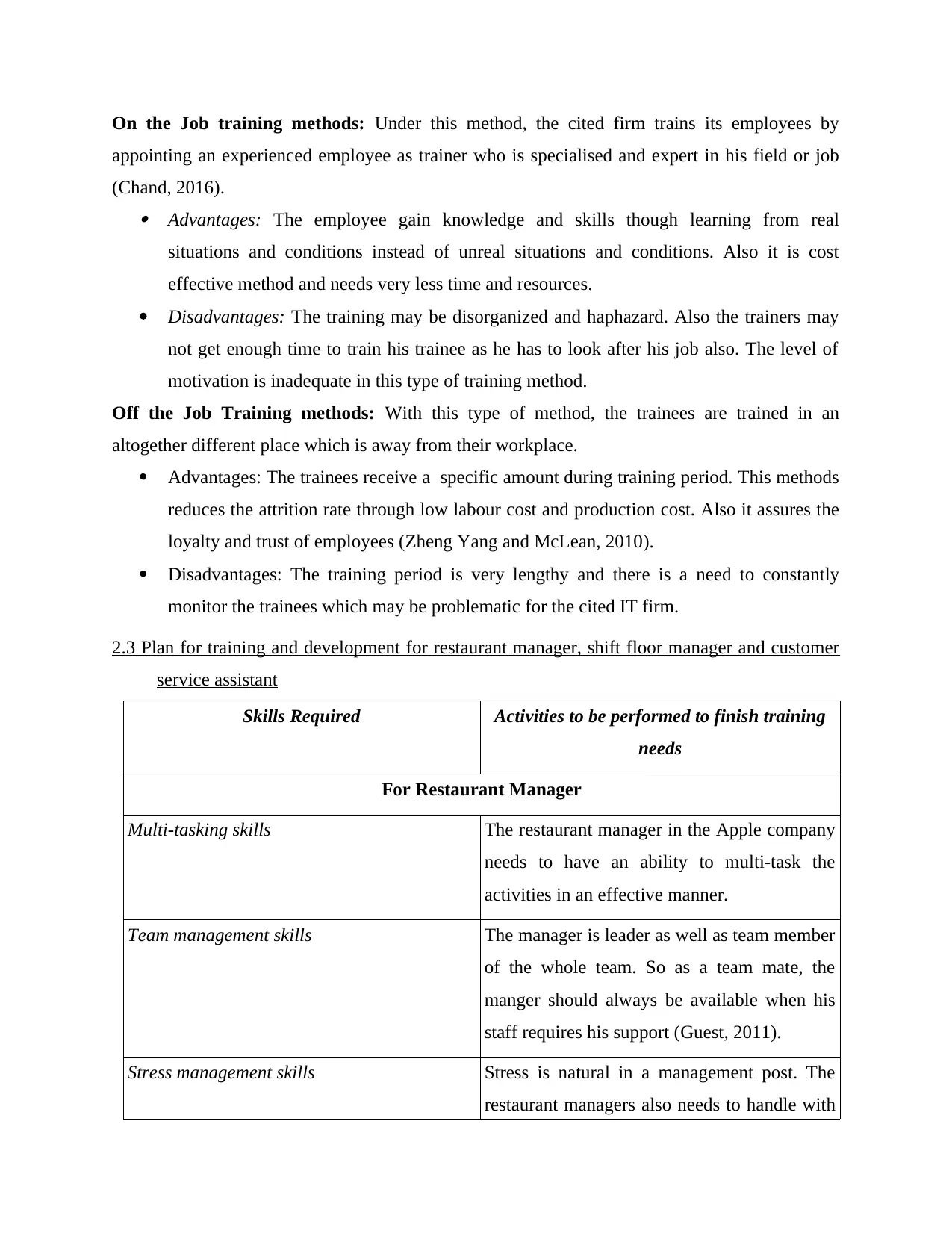
On the Job training methods: Under this method, the cited firm trains its employees by
appointing an experienced employee as trainer who is specialised and expert in his field or job
(Chand, 2016). Advantages: The employee gain knowledge and skills though learning from real
situations and conditions instead of unreal situations and conditions. Also it is cost
effective method and needs very less time and resources.
Disadvantages: The training may be disorganized and haphazard. Also the trainers may
not get enough time to train his trainee as he has to look after his job also. The level of
motivation is inadequate in this type of training method.
Off the Job Training methods: With this type of method, the trainees are trained in an
altogether different place which is away from their workplace.
Advantages: The trainees receive a specific amount during training period. This methods
reduces the attrition rate through low labour cost and production cost. Also it assures the
loyalty and trust of employees (Zheng Yang and McLean, 2010).
Disadvantages: The training period is very lengthy and there is a need to constantly
monitor the trainees which may be problematic for the cited IT firm.
2.3 Plan for training and development for restaurant manager, shift floor manager and customer
service assistant
Skills Required Activities to be performed to finish training
needs
For Restaurant Manager
Multi-tasking skills The restaurant manager in the Apple company
needs to have an ability to multi-task the
activities in an effective manner.
Team management skills The manager is leader as well as team member
of the whole team. So as a team mate, the
manger should always be available when his
staff requires his support (Guest, 2011).
Stress management skills Stress is natural in a management post. The
restaurant managers also needs to handle with
appointing an experienced employee as trainer who is specialised and expert in his field or job
(Chand, 2016). Advantages: The employee gain knowledge and skills though learning from real
situations and conditions instead of unreal situations and conditions. Also it is cost
effective method and needs very less time and resources.
Disadvantages: The training may be disorganized and haphazard. Also the trainers may
not get enough time to train his trainee as he has to look after his job also. The level of
motivation is inadequate in this type of training method.
Off the Job Training methods: With this type of method, the trainees are trained in an
altogether different place which is away from their workplace.
Advantages: The trainees receive a specific amount during training period. This methods
reduces the attrition rate through low labour cost and production cost. Also it assures the
loyalty and trust of employees (Zheng Yang and McLean, 2010).
Disadvantages: The training period is very lengthy and there is a need to constantly
monitor the trainees which may be problematic for the cited IT firm.
2.3 Plan for training and development for restaurant manager, shift floor manager and customer
service assistant
Skills Required Activities to be performed to finish training
needs
For Restaurant Manager
Multi-tasking skills The restaurant manager in the Apple company
needs to have an ability to multi-task the
activities in an effective manner.
Team management skills The manager is leader as well as team member
of the whole team. So as a team mate, the
manger should always be available when his
staff requires his support (Guest, 2011).
Stress management skills Stress is natural in a management post. The
restaurant managers also needs to handle with
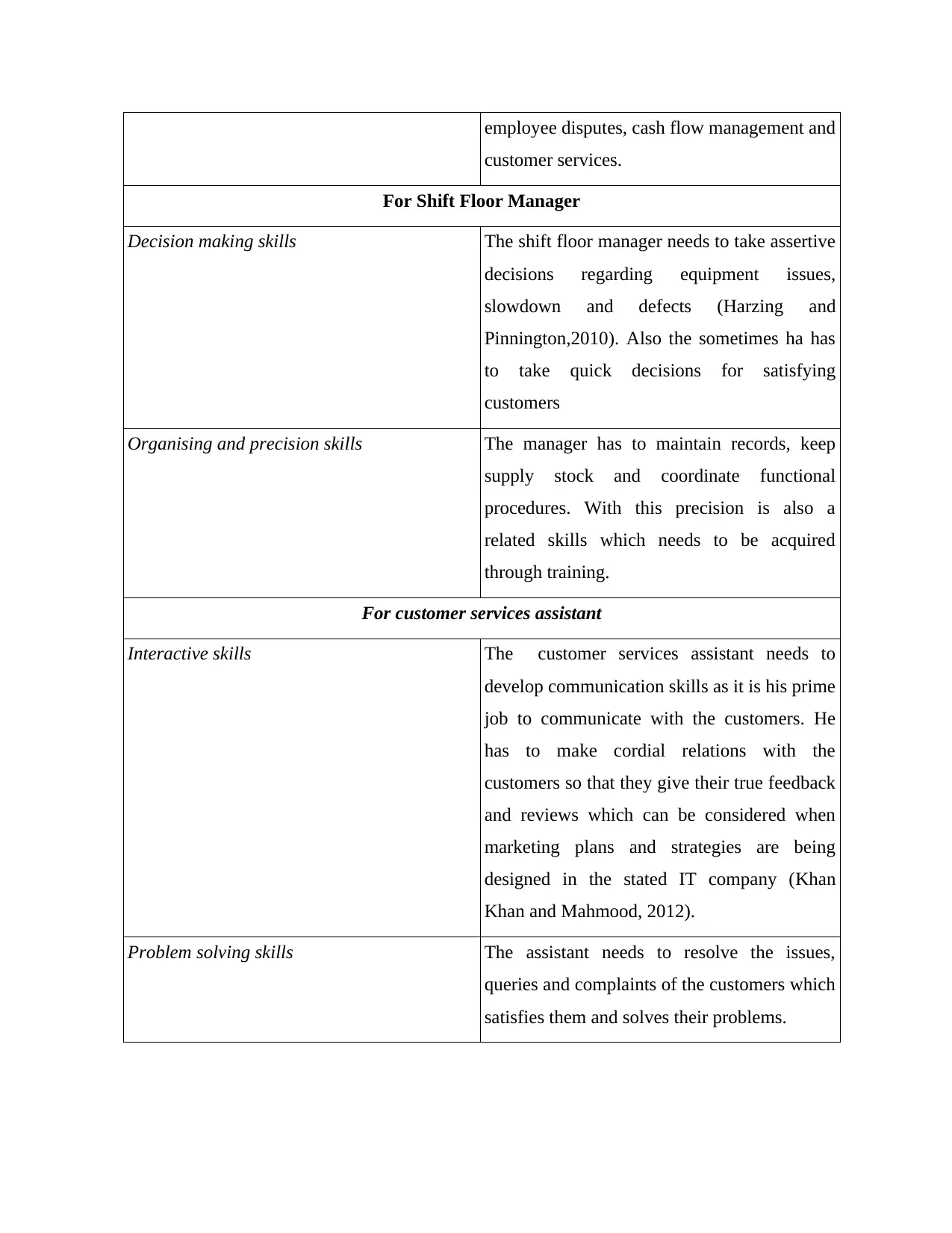
employee disputes, cash flow management and
customer services.
For Shift Floor Manager
Decision making skills The shift floor manager needs to take assertive
decisions regarding equipment issues,
slowdown and defects (Harzing and
Pinnington,2010). Also the sometimes ha has
to take quick decisions for satisfying
customers
Organising and precision skills The manager has to maintain records, keep
supply stock and coordinate functional
procedures. With this precision is also a
related skills which needs to be acquired
through training.
For customer services assistant
Interactive skills The customer services assistant needs to
develop communication skills as it is his prime
job to communicate with the customers. He
has to make cordial relations with the
customers so that they give their true feedback
and reviews which can be considered when
marketing plans and strategies are being
designed in the stated IT company (Khan
Khan and Mahmood, 2012).
Problem solving skills The assistant needs to resolve the issues,
queries and complaints of the customers which
satisfies them and solves their problems.
customer services.
For Shift Floor Manager
Decision making skills The shift floor manager needs to take assertive
decisions regarding equipment issues,
slowdown and defects (Harzing and
Pinnington,2010). Also the sometimes ha has
to take quick decisions for satisfying
customers
Organising and precision skills The manager has to maintain records, keep
supply stock and coordinate functional
procedures. With this precision is also a
related skills which needs to be acquired
through training.
For customer services assistant
Interactive skills The customer services assistant needs to
develop communication skills as it is his prime
job to communicate with the customers. He
has to make cordial relations with the
customers so that they give their true feedback
and reviews which can be considered when
marketing plans and strategies are being
designed in the stated IT company (Khan
Khan and Mahmood, 2012).
Problem solving skills The assistant needs to resolve the issues,
queries and complaints of the customers which
satisfies them and solves their problems.
⊘ This is a preview!⊘
Do you want full access?
Subscribe today to unlock all pages.

Trusted by 1+ million students worldwide
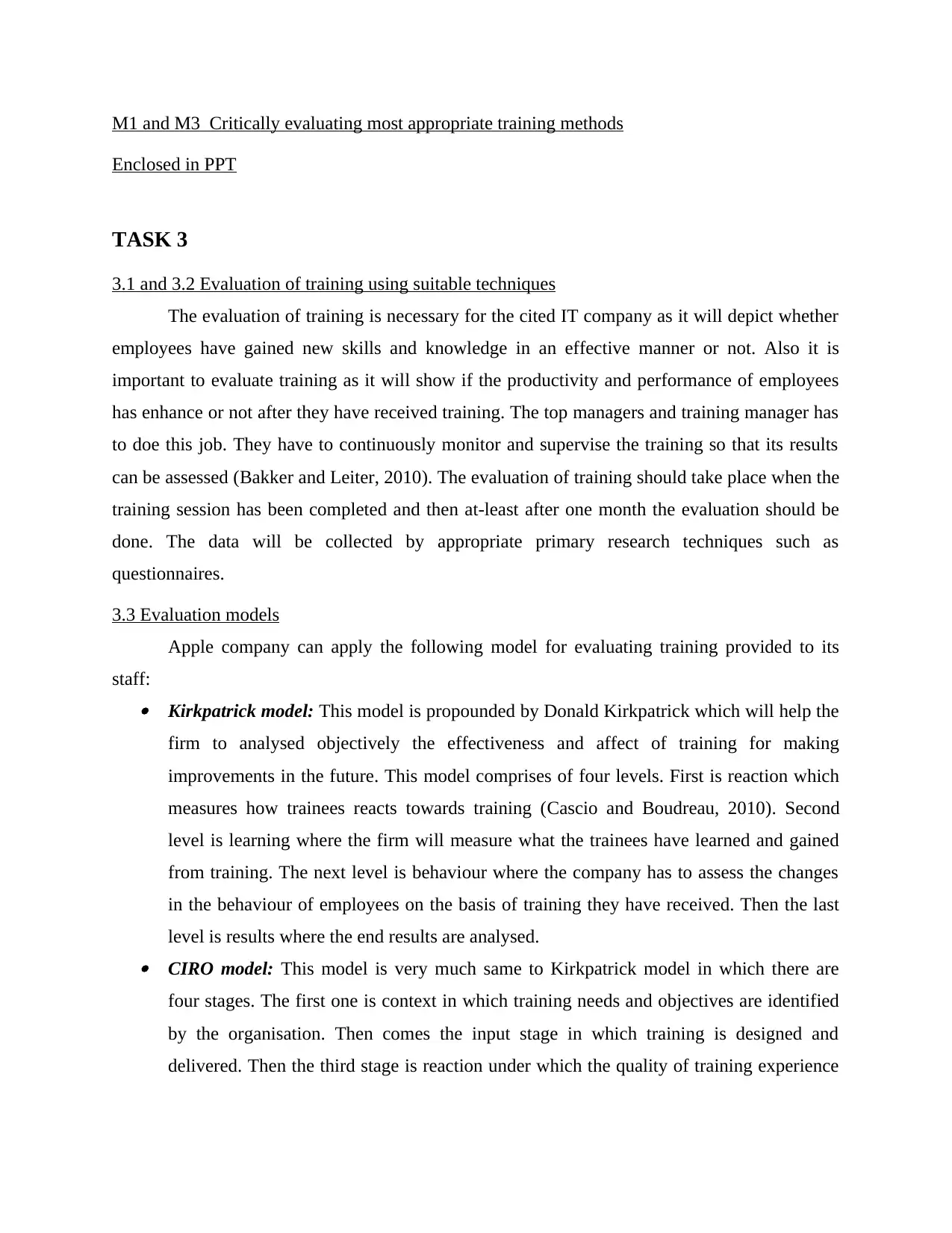
M1 and M3 Critically evaluating most appropriate training methods
Enclosed in PPT
TASK 3
3.1 and 3.2 Evaluation of training using suitable techniques
The evaluation of training is necessary for the cited IT company as it will depict whether
employees have gained new skills and knowledge in an effective manner or not. Also it is
important to evaluate training as it will show if the productivity and performance of employees
has enhance or not after they have received training. The top managers and training manager has
to doe this job. They have to continuously monitor and supervise the training so that its results
can be assessed (Bakker and Leiter, 2010). The evaluation of training should take place when the
training session has been completed and then at-least after one month the evaluation should be
done. The data will be collected by appropriate primary research techniques such as
questionnaires.
3.3 Evaluation models
Apple company can apply the following model for evaluating training provided to its
staff: Kirkpatrick model: This model is propounded by Donald Kirkpatrick which will help the
firm to analysed objectively the effectiveness and affect of training for making
improvements in the future. This model comprises of four levels. First is reaction which
measures how trainees reacts towards training (Cascio and Boudreau, 2010). Second
level is learning where the firm will measure what the trainees have learned and gained
from training. The next level is behaviour where the company has to assess the changes
in the behaviour of employees on the basis of training they have received. Then the last
level is results where the end results are analysed. CIRO model: This model is very much same to Kirkpatrick model in which there are
four stages. The first one is context in which training needs and objectives are identified
by the organisation. Then comes the input stage in which training is designed and
delivered. Then the third stage is reaction under which the quality of training experience
Enclosed in PPT
TASK 3
3.1 and 3.2 Evaluation of training using suitable techniques
The evaluation of training is necessary for the cited IT company as it will depict whether
employees have gained new skills and knowledge in an effective manner or not. Also it is
important to evaluate training as it will show if the productivity and performance of employees
has enhance or not after they have received training. The top managers and training manager has
to doe this job. They have to continuously monitor and supervise the training so that its results
can be assessed (Bakker and Leiter, 2010). The evaluation of training should take place when the
training session has been completed and then at-least after one month the evaluation should be
done. The data will be collected by appropriate primary research techniques such as
questionnaires.
3.3 Evaluation models
Apple company can apply the following model for evaluating training provided to its
staff: Kirkpatrick model: This model is propounded by Donald Kirkpatrick which will help the
firm to analysed objectively the effectiveness and affect of training for making
improvements in the future. This model comprises of four levels. First is reaction which
measures how trainees reacts towards training (Cascio and Boudreau, 2010). Second
level is learning where the firm will measure what the trainees have learned and gained
from training. The next level is behaviour where the company has to assess the changes
in the behaviour of employees on the basis of training they have received. Then the last
level is results where the end results are analysed. CIRO model: This model is very much same to Kirkpatrick model in which there are
four stages. The first one is context in which training needs and objectives are identified
by the organisation. Then comes the input stage in which training is designed and
delivered. Then the third stage is reaction under which the quality of training experience
Paraphrase This Document
Need a fresh take? Get an instant paraphrase of this document with our AI Paraphraser
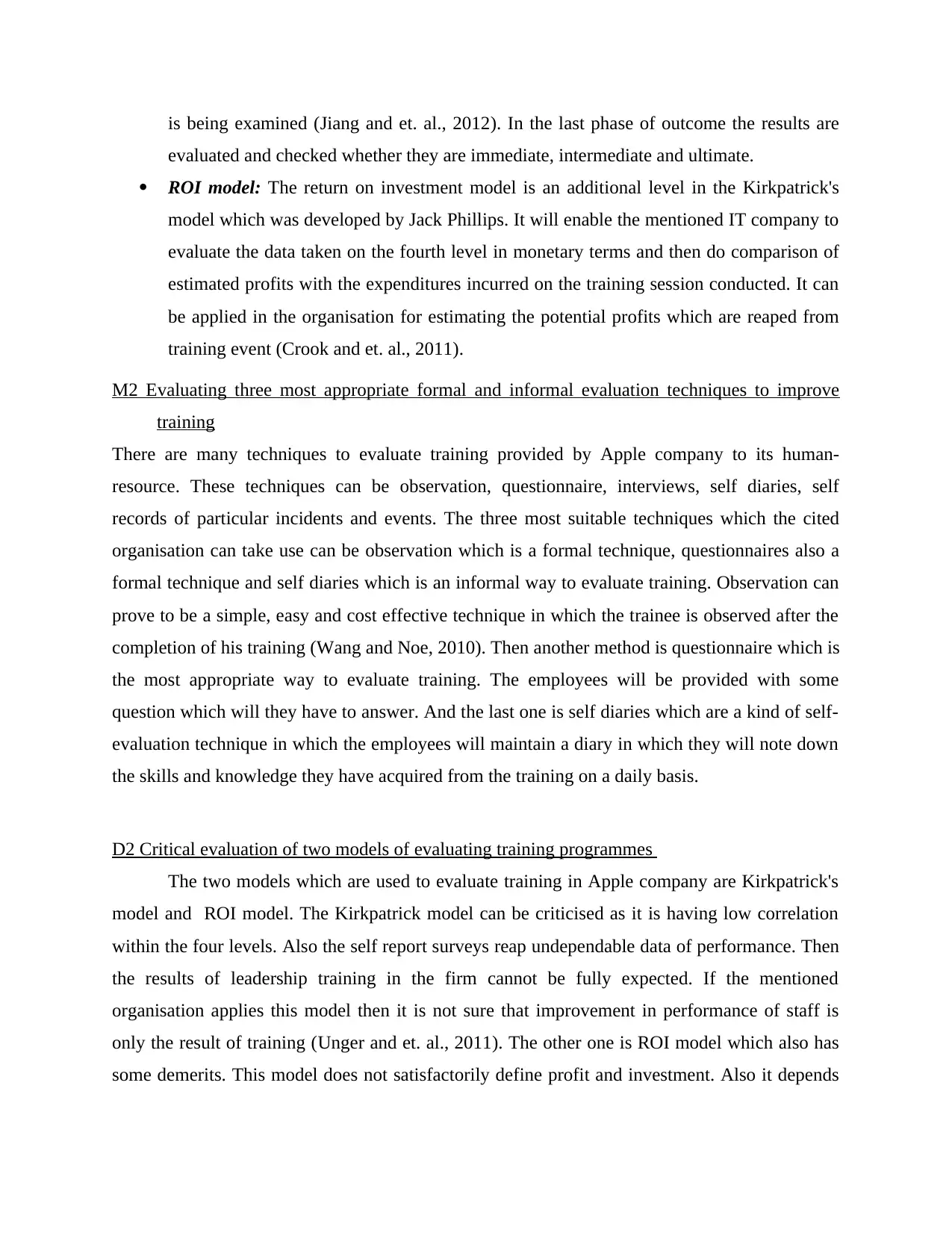
is being examined (Jiang and et. al., 2012). In the last phase of outcome the results are
evaluated and checked whether they are immediate, intermediate and ultimate.
ROI model: The return on investment model is an additional level in the Kirkpatrick's
model which was developed by Jack Phillips. It will enable the mentioned IT company to
evaluate the data taken on the fourth level in monetary terms and then do comparison of
estimated profits with the expenditures incurred on the training session conducted. It can
be applied in the organisation for estimating the potential profits which are reaped from
training event (Crook and et. al., 2011).
M2 Evaluating three most appropriate formal and informal evaluation techniques to improve
training
There are many techniques to evaluate training provided by Apple company to its human-
resource. These techniques can be observation, questionnaire, interviews, self diaries, self
records of particular incidents and events. The three most suitable techniques which the cited
organisation can take use can be observation which is a formal technique, questionnaires also a
formal technique and self diaries which is an informal way to evaluate training. Observation can
prove to be a simple, easy and cost effective technique in which the trainee is observed after the
completion of his training (Wang and Noe, 2010). Then another method is questionnaire which is
the most appropriate way to evaluate training. The employees will be provided with some
question which will they have to answer. And the last one is self diaries which are a kind of self-
evaluation technique in which the employees will maintain a diary in which they will note down
the skills and knowledge they have acquired from the training on a daily basis.
D2 Critical evaluation of two models of evaluating training programmes
The two models which are used to evaluate training in Apple company are Kirkpatrick's
model and ROI model. The Kirkpatrick model can be criticised as it is having low correlation
within the four levels. Also the self report surveys reap undependable data of performance. Then
the results of leadership training in the firm cannot be fully expected. If the mentioned
organisation applies this model then it is not sure that improvement in performance of staff is
only the result of training (Unger and et. al., 2011). The other one is ROI model which also has
some demerits. This model does not satisfactorily define profit and investment. Also it depends
evaluated and checked whether they are immediate, intermediate and ultimate.
ROI model: The return on investment model is an additional level in the Kirkpatrick's
model which was developed by Jack Phillips. It will enable the mentioned IT company to
evaluate the data taken on the fourth level in monetary terms and then do comparison of
estimated profits with the expenditures incurred on the training session conducted. It can
be applied in the organisation for estimating the potential profits which are reaped from
training event (Crook and et. al., 2011).
M2 Evaluating three most appropriate formal and informal evaluation techniques to improve
training
There are many techniques to evaluate training provided by Apple company to its human-
resource. These techniques can be observation, questionnaire, interviews, self diaries, self
records of particular incidents and events. The three most suitable techniques which the cited
organisation can take use can be observation which is a formal technique, questionnaires also a
formal technique and self diaries which is an informal way to evaluate training. Observation can
prove to be a simple, easy and cost effective technique in which the trainee is observed after the
completion of his training (Wang and Noe, 2010). Then another method is questionnaire which is
the most appropriate way to evaluate training. The employees will be provided with some
question which will they have to answer. And the last one is self diaries which are a kind of self-
evaluation technique in which the employees will maintain a diary in which they will note down
the skills and knowledge they have acquired from the training on a daily basis.
D2 Critical evaluation of two models of evaluating training programmes
The two models which are used to evaluate training in Apple company are Kirkpatrick's
model and ROI model. The Kirkpatrick model can be criticised as it is having low correlation
within the four levels. Also the self report surveys reap undependable data of performance. Then
the results of leadership training in the firm cannot be fully expected. If the mentioned
organisation applies this model then it is not sure that improvement in performance of staff is
only the result of training (Unger and et. al., 2011). The other one is ROI model which also has
some demerits. This model does not satisfactorily define profit and investment. Also it depends
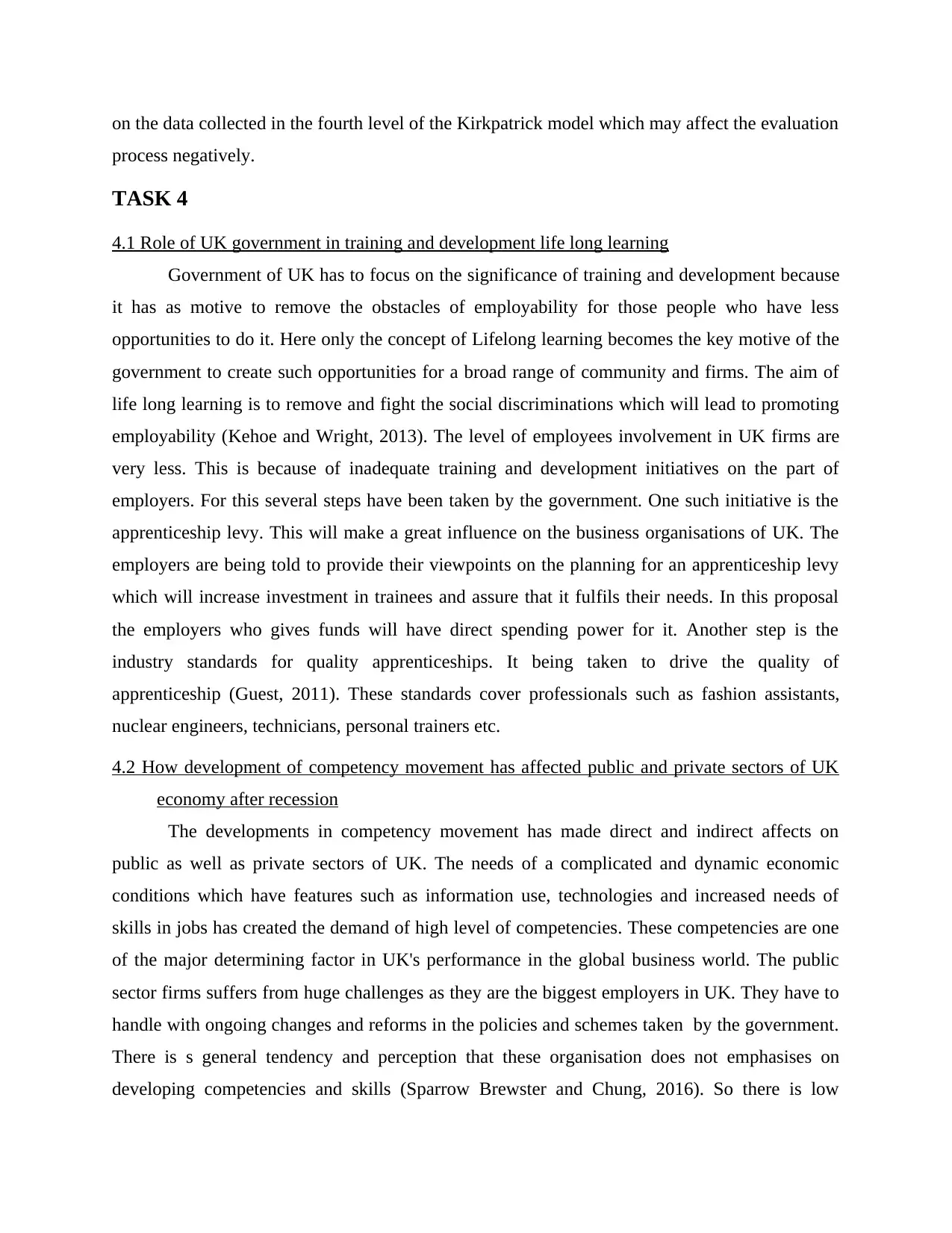
on the data collected in the fourth level of the Kirkpatrick model which may affect the evaluation
process negatively.
TASK 4
4.1 Role of UK government in training and development life long learning
Government of UK has to focus on the significance of training and development because
it has as motive to remove the obstacles of employability for those people who have less
opportunities to do it. Here only the concept of Lifelong learning becomes the key motive of the
government to create such opportunities for a broad range of community and firms. The aim of
life long learning is to remove and fight the social discriminations which will lead to promoting
employability (Kehoe and Wright, 2013). The level of employees involvement in UK firms are
very less. This is because of inadequate training and development initiatives on the part of
employers. For this several steps have been taken by the government. One such initiative is the
apprenticeship levy. This will make a great influence on the business organisations of UK. The
employers are being told to provide their viewpoints on the planning for an apprenticeship levy
which will increase investment in trainees and assure that it fulfils their needs. In this proposal
the employers who gives funds will have direct spending power for it. Another step is the
industry standards for quality apprenticeships. It being taken to drive the quality of
apprenticeship (Guest, 2011). These standards cover professionals such as fashion assistants,
nuclear engineers, technicians, personal trainers etc.
4.2 How development of competency movement has affected public and private sectors of UK
economy after recession
The developments in competency movement has made direct and indirect affects on
public as well as private sectors of UK. The needs of a complicated and dynamic economic
conditions which have features such as information use, technologies and increased needs of
skills in jobs has created the demand of high level of competencies. These competencies are one
of the major determining factor in UK's performance in the global business world. The public
sector firms suffers from huge challenges as they are the biggest employers in UK. They have to
handle with ongoing changes and reforms in the policies and schemes taken by the government.
There is s general tendency and perception that these organisation does not emphasises on
developing competencies and skills (Sparrow Brewster and Chung, 2016). So there is low
process negatively.
TASK 4
4.1 Role of UK government in training and development life long learning
Government of UK has to focus on the significance of training and development because
it has as motive to remove the obstacles of employability for those people who have less
opportunities to do it. Here only the concept of Lifelong learning becomes the key motive of the
government to create such opportunities for a broad range of community and firms. The aim of
life long learning is to remove and fight the social discriminations which will lead to promoting
employability (Kehoe and Wright, 2013). The level of employees involvement in UK firms are
very less. This is because of inadequate training and development initiatives on the part of
employers. For this several steps have been taken by the government. One such initiative is the
apprenticeship levy. This will make a great influence on the business organisations of UK. The
employers are being told to provide their viewpoints on the planning for an apprenticeship levy
which will increase investment in trainees and assure that it fulfils their needs. In this proposal
the employers who gives funds will have direct spending power for it. Another step is the
industry standards for quality apprenticeships. It being taken to drive the quality of
apprenticeship (Guest, 2011). These standards cover professionals such as fashion assistants,
nuclear engineers, technicians, personal trainers etc.
4.2 How development of competency movement has affected public and private sectors of UK
economy after recession
The developments in competency movement has made direct and indirect affects on
public as well as private sectors of UK. The needs of a complicated and dynamic economic
conditions which have features such as information use, technologies and increased needs of
skills in jobs has created the demand of high level of competencies. These competencies are one
of the major determining factor in UK's performance in the global business world. The public
sector firms suffers from huge challenges as they are the biggest employers in UK. They have to
handle with ongoing changes and reforms in the policies and schemes taken by the government.
There is s general tendency and perception that these organisation does not emphasises on
developing competencies and skills (Sparrow Brewster and Chung, 2016). So there is low
⊘ This is a preview!⊘
Do you want full access?
Subscribe today to unlock all pages.

Trusted by 1+ million students worldwide
1 out of 16
Related Documents
Your All-in-One AI-Powered Toolkit for Academic Success.
+13062052269
info@desklib.com
Available 24*7 on WhatsApp / Email
![[object Object]](/_next/static/media/star-bottom.7253800d.svg)
Unlock your academic potential
Copyright © 2020–2025 A2Z Services. All Rights Reserved. Developed and managed by ZUCOL.





